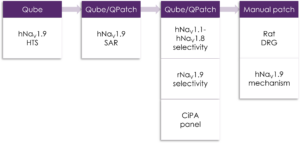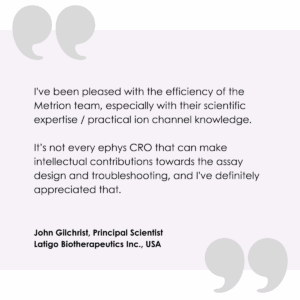
Ion channels are a major class of drug targets for modulating pain transmission and controlling chronic pain. The voltage-gated sodium channel, NaV1.9, has been identified as a critical component of pain signalling. While NaV1.9 holds great promise as a non-opioid pain target, the discovery and development of new chemical entities has been hampered by the availability of robust cellular reagents suitable for high-throughput electrophysiology.
Metrion has addressed this challenge with the development of robust stably expressing NaV1.9 cell lines (human and rat) which have been validated on the QPatch 48 and Qube 384 electrophysiology systems. This enables:
Alongside our highly experienced electrophysiologists, Metrion’s NaV1.9 drug discovery assays, in combination with other pain research related services, sets the Metrion offering apart from others by combining the following to support our customers’ discovery needs:

Figure 1. Example of Metrion's NaV1.9 screening cascade.
NaV1.9 is a voltage-gated sodium channel predominantly expressed in peripheral sensory neurons, where it plays a vital role in pain signalling. These channels contribute to the excitability of nociceptive neurons directly influencing pain pathways. The unique biophysical properties of NaV1.9 plays a key role in regulating the threshold for neuronal firing and is seen as an attractive target for non-opioid pain management.
NaV1.9 has been linked to various pain disorders through genetic mutations leading to both chronic pain syndromes and insensitivity to pain. These discoveries further support the significance of NaV1.9 in pain physiology and the importance of this particular sodium channel subtype as a pain target.
Despite its importance in pain research, NaV1.9 remains one of the most difficult sodium channel targets to prosecute due to:
Metrion has overcome these challenges by developing robust NaV1.9 cell lines which have been validated using the QPatch 48 and Qube 384 providing high quality reproducible data.
These enhancements place Metrion at the forefront of NaV1.9 drug discovery.

Figure 2. Example family of current recordings of hNaV1.9 using the Qube automated electrophysiology platform (A). Current-voltage relationship of hNaV1.9 (B).
Leading the way in NaV1.9 hit finding, Metrion has exceptional expertise in automated electrophysiology platforms, which delivers:
 Uniquely positioned as a leader in ion channel drug discovery, Metrion scientists have extensive experience in neuroscience, in particular pain, gained from both academic and industry environments. By partnering with Metrion, customers benefit from:
Uniquely positioned as a leader in ion channel drug discovery, Metrion scientists have extensive experience in neuroscience, in particular pain, gained from both academic and industry environments. By partnering with Metrion, customers benefit from:
Metrion continues to lead the way in ion channel research, and the launch of its NaV1.9 capabilities represent a significant advancement in pain drug discovery. By addressing key challenges associated with NaV1.9, the use of cutting-edge automated patch clamp technology and rodent translational models, Metrion is ready to support your projects to identify new pain therapies.
For scientists looking to accelerate their drug discovery efforts, Metrion provides the expertise, technology, and support necessary to achieve breakthrough discoveries. As the demand for non-opioid pain therapeutics grows, Metrion’s commitment to innovation will continue to drive progress in this crucial field.
Contact us today to learn how Metrion’s cutting-edge pain research services can help you achieve your research goals:

Ion channels are a major class of drug targets for modulating pain transmission and controlling chronic pain. The voltage-gated sodium channel, NaV1.9, has been identified as a critical component of pain signalling. While NaV1.9 holds great promise as a non-opioid pain target, the discovery and development of new chemical entities has been hampered by the availability of robust cellular reagents suitable for high-throughput electrophysiology.
Metrion has addressed this challenge with the development of robust stably expressing NaV1.9 cell lines (human and rat) which have been validated on the QPatch 48 and Qube 384 electrophysiology systems. This enables:
Alongside our highly experienced electrophysiologists, Metrion’s NaV1.9 drug discovery assays, in combination with other pain research related services, sets the Metrion offering apart from others by combining the following to support our customers’ discovery needs:

Figure 1. Example of Metrion's NaV1.9 screening cascade.
NaV1.9 is a voltage-gated sodium channel predominantly expressed in peripheral sensory neurons, where it plays a vital role in pain signalling. These channels contribute to the excitability of nociceptive neurons directly influencing pain pathways. The unique biophysical properties of NaV1.9 plays a key role in regulating the threshold for neuronal firing and is seen as an attractive target for non-opioid pain management.
NaV1.9 has been linked to various pain disorders through genetic mutations leading to both chronic pain syndromes and insensitivity to pain. These discoveries further support the significance of NaV1.9 in pain physiology and the importance of this particular sodium channel subtype as a pain target.
Despite its importance in pain research, NaV1.9 remains one of the most difficult sodium channel targets to prosecute due to:
Metrion has overcome these challenges by developing robust NaV1.9 cell lines which have been validated using the QPatch 48 and Qube 384 providing high quality reproducible data.
These enhancements place Metrion at the forefront of NaV1.9 drug discovery.

Figure 2. Example family of current recordings of hNaV1.9 using the Qube automated electrophysiology platform (A). Current-voltage relationship of hNaV1.9 (B).
Leading the way in NaV1.9 hit finding, Metrion has exceptional expertise in automated electrophysiology platforms, which delivers:
 Uniquely positioned as a leader in ion channel drug discovery, Metrion scientists have extensive experience in neuroscience, in particular pain, gained from both academic and industry environments. By partnering with Metrion, customers benefit from:
Uniquely positioned as a leader in ion channel drug discovery, Metrion scientists have extensive experience in neuroscience, in particular pain, gained from both academic and industry environments. By partnering with Metrion, customers benefit from:
Metrion continues to lead the way in ion channel research, and the launch of its NaV1.9 capabilities represent a significant advancement in pain drug discovery. By addressing key challenges associated with NaV1.9, the use of cutting-edge automated patch clamp technology and rodent translational models, Metrion is ready to support your projects to identify new pain therapies.
For scientists looking to accelerate their drug discovery efforts, Metrion provides the expertise, technology, and support necessary to achieve breakthrough discoveries. As the demand for non-opioid pain therapeutics grows, Metrion’s commitment to innovation will continue to drive progress in this crucial field.
Contact us today to learn how Metrion’s cutting-edge pain research services can help you achieve your research goals:

Ion channels are a major class of drug targets for modulating pain transmission and controlling chronic pain. The voltage-gated sodium channel, NaV1.9, has been identified as a critical component of pain signalling. While NaV1.9 holds great promise as a non-opioid pain target, the discovery and development of new chemical entities has been hampered by the availability of robust cellular reagents suitable for high-throughput electrophysiology.
Metrion has addressed this challenge with the development of robust stably expressing NaV1.9 cell lines (human and rat) which have been validated on the QPatch 48 and Qube 384 electrophysiology systems. This enables:
Alongside our highly experienced electrophysiologists, Metrion’s NaV1.9 drug discovery assays, in combination with other pain research related services, sets the Metrion offering apart from others by combining the following to support our customers’ discovery needs:

Figure 1. Example of Metrion's NaV1.9 screening cascade.
NaV1.9 is a voltage-gated sodium channel predominantly expressed in peripheral sensory neurons, where it plays a vital role in pain signalling. These channels contribute to the excitability of nociceptive neurons directly influencing pain pathways. The unique biophysical properties of NaV1.9 plays a key role in regulating the threshold for neuronal firing and is seen as an attractive target for non-opioid pain management.
NaV1.9 has been linked to various pain disorders through genetic mutations leading to both chronic pain syndromes and insensitivity to pain. These discoveries further support the significance of NaV1.9 in pain physiology and the importance of this particular sodium channel subtype as a pain target.
Despite its importance in pain research, NaV1.9 remains one of the most difficult sodium channel targets to prosecute due to:
Metrion has overcome these challenges by developing robust NaV1.9 cell lines which have been validated using the QPatch 48 and Qube 384 providing high quality reproducible data.
These enhancements place Metrion at the forefront of NaV1.9 drug discovery.

Figure 2. Example family of current recordings of hNaV1.9 using the Qube automated electrophysiology platform (A). Current-voltage relationship of hNaV1.9 (B).
Leading the way in NaV1.9 hit finding, Metrion has exceptional expertise in automated electrophysiology platforms, which delivers:
 Uniquely positioned as a leader in ion channel drug discovery, Metrion scientists have extensive experience in neuroscience, in particular pain, gained from both academic and industry environments. By partnering with Metrion, customers benefit from:
Uniquely positioned as a leader in ion channel drug discovery, Metrion scientists have extensive experience in neuroscience, in particular pain, gained from both academic and industry environments. By partnering with Metrion, customers benefit from:
Metrion continues to lead the way in ion channel research, and the launch of its NaV1.9 capabilities represent a significant advancement in pain drug discovery. By addressing key challenges associated with NaV1.9, the use of cutting-edge automated patch clamp technology and rodent translational models, Metrion is ready to support your projects to identify new pain therapies.
For scientists looking to accelerate their drug discovery efforts, Metrion provides the expertise, technology, and support necessary to achieve breakthrough discoveries. As the demand for non-opioid pain therapeutics grows, Metrion’s commitment to innovation will continue to drive progress in this crucial field.
Contact us today to learn how Metrion’s cutting-edge pain research services can help you achieve your research goals: